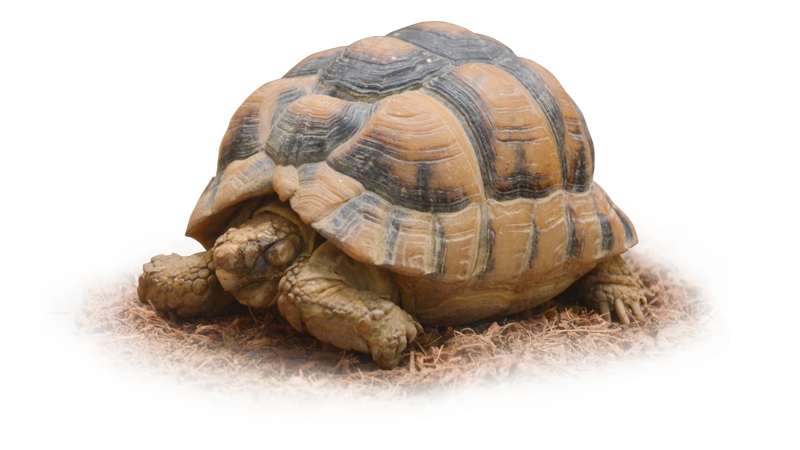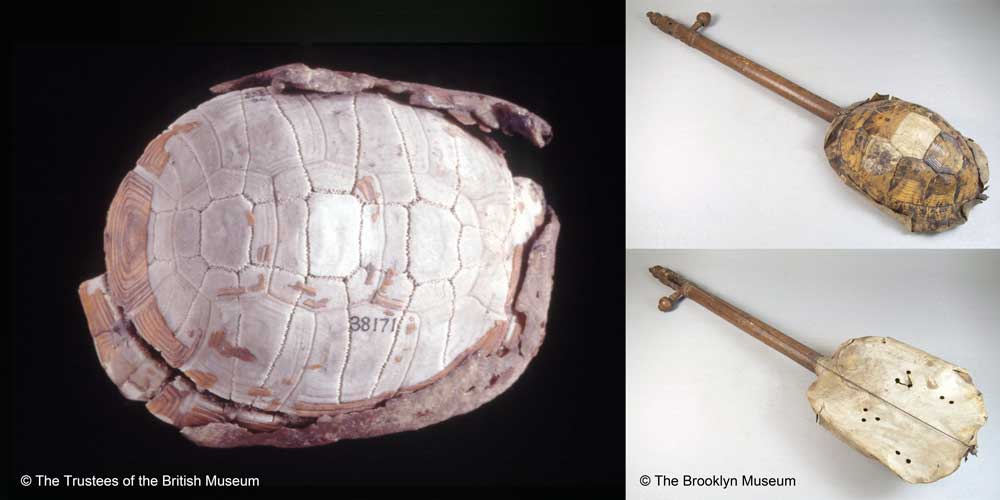
Testudo kleinmanni (Lortet, 1883)
リクガメのリュートはどんな音だった?
What Kind of Sound Does a Lute Made From a Tortoise Shell Produce?
北半球でいちばん小さなリクガメであり、甲長は約13cmです。甲羅の形はドーム状に盛り上がっており、全体的にクリーム色の体色ですが、シームと呼ばれる甲板のつなぎ目は暗色です。かつてエジプト、リビア、イスラエルに分布しておりましたが、現在ではリビアの限られた地域のみで生息しており、他の地域では絶滅したと考えられます。
個体数減少の一因はペット取引のための乱獲です。乾燥に強いリクガメであり、手頃な大きさなので、密輸の標的となり、現在ではワシントン条約(CITES)の附属書Iに指定されていますが、密輸は後を断ちません。逆にそのことで希少価値が高まり、高値で取引されるようになるという弊害もあるようです。日本では2003年に動物園から5頭盗まれたこともありました。元々湿潤な気候の日本では飼育は難しいとされてきた種ですが、盗難されたカメがその後どうなったかは定かではありません。
種小名のTestudo kleinmanni はフランスの銀行家Édouard Kleinmann (1823-1901)の名前を冠しています。彼はエジプト滞在中に本種と出会い1883年に学会に新種として報告したのでした。しかしエジプトでは古代より一般的なリクガメとして知られており、甲羅を加工して指輪や櫛が作られたり、ボウルとして使用したり、弦楽器リュートの胴として利用していたようです。リクガメは古代エジプトにおいて庶民の暮らしに役立つ存在であったようです。

(Left) A Lute with a body made of tortoise shell in ancient Egypt. From the collection of the British Museum.
(Right) A lute made using a tortoise shell, dating from the late 19th to early 20th century. From the collection of the Brooklyn Museum.
This is the smallest tortoise in the northern hemisphere, with a shell length of approximately 13 cm. Its shell is dome-shaped and generally cream-colored, with dark seams where the plates meet. It was once found in Egypt, Libya, and Israel, but now survives only in a limited area of Libya; it is considered extinct in other regions.
One reason for its population decline is over-exploitation for the pet trade. This tortoise is drought-tolerant and small enough to be easily transported, making it a target for smugglers. Although it is now listed on Appendix I of CITES (Convention on International Trade in Endangered Species), smuggling continues. Ironically, this has increased its perceived rarity and value, leading to higher prices. In 2003, five of these tortoises were stolen from a zoo in Japan. While this species is generally considered difficult to keep in the humid climate of Japan, the fate of the stolen tortoises remains unknown.
The species name, “Testudo kleinmanni“, honors the French banker Édouard Kleinmann (1823-1901). He discovered the species while in Egypt and reported it as a new species to the scientific community in 1883. However, in ancient Egypt, this type of tortoise was a common and well-known species. Its shell was used to make various items, such as rings and combs, or used as bowls or even as the body of stringed instruments like the lute. It seems that tortoises played a useful role in the daily lives of ordinary people in ancient Egypt.
参考文献
“”Egyptian Tortoise” Maryland Zoo. 2025年9月20日閲覧
Perälä, J. 2003. Testudo kleinmanni. The IUCN Red List of Threatened Species 2003: e.T21652A9306908. 2025年9月20日閲覧
タイランド ハイパーリンクス | スワンナプーム空港でエジプトリクガメ187匹を押収、ラオスへ密輸未遂 | (2025年9月14日) 2025年9月20日閲覧
佐久間弘行, 佐藤美穂, 千本隆太. 水池聡 (2011年12月30日)「リクガメの密猟とワシントン条約規制の効果」大沼あゆみ研究会, 慶應義塾大学 2025年9月20日閲覧
夢見ヶ崎動物公園 | 夢見の動物 | エジプトリクガメ | (2003年10月25日) 2025年9月20日閲覧
亀岡 昌子, 清野 比咲子 (2005年2月)「日本における淡水ガメ・リクガメの市場調査」トラフィックイーストアジアジャパン 2025年9月20日閲覧
Raffaele, Francesco (2002) “Turtles in Predynastic and Early Dynastic Egypt”International Council of Archaeozoology. 2025年9月20日閲覧
“Lute late 19th or early 20th century” Collection, Brooklyn Museum. 2025年9月20日閲覧
Dorman, Nerine (2025, June 6) “Exploring music in ancient Egypt” The Egyptian Society of South Africa. 2025年9月20日閲覧
“lute” collection, The British Museum. 2025年9月20日閲覧